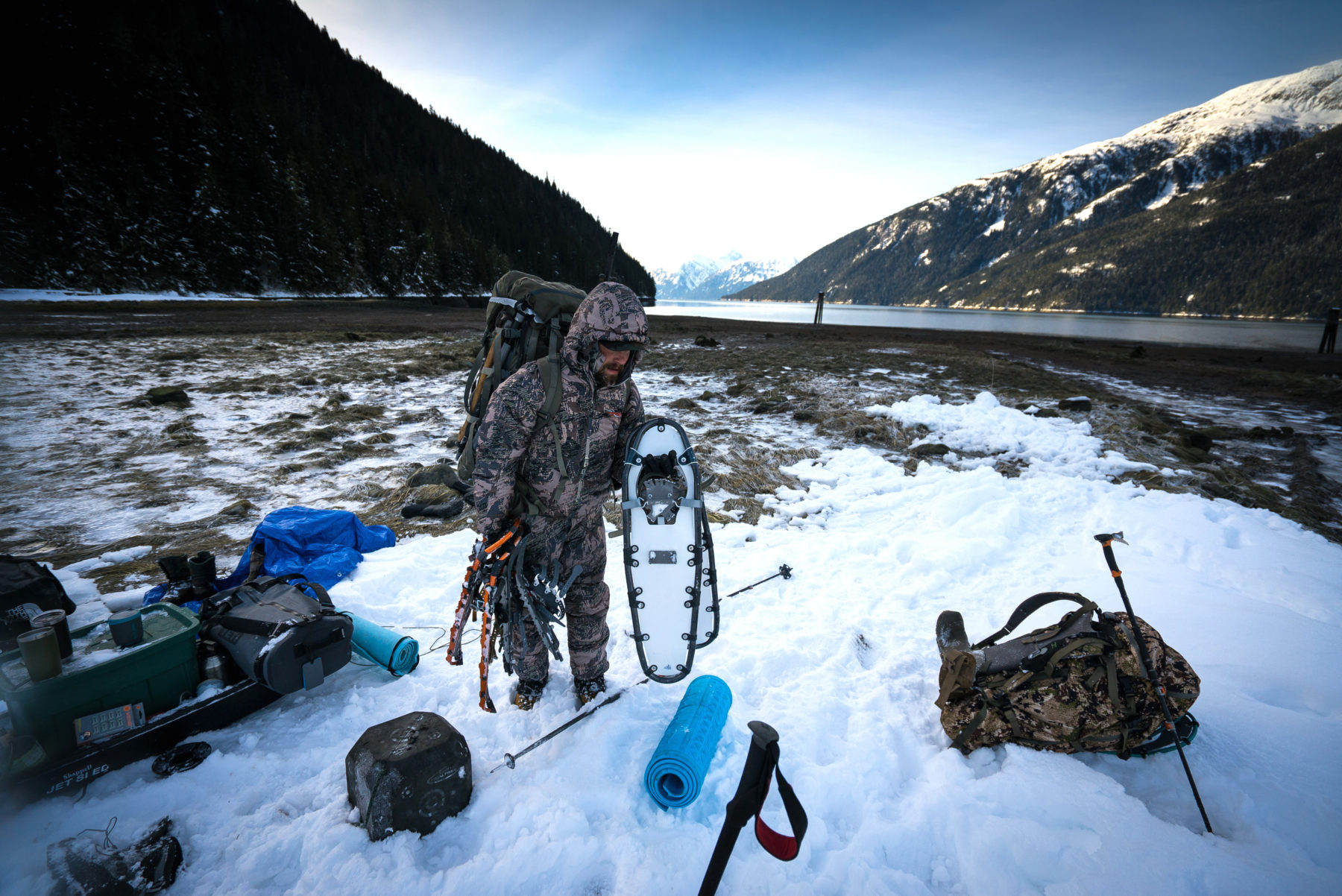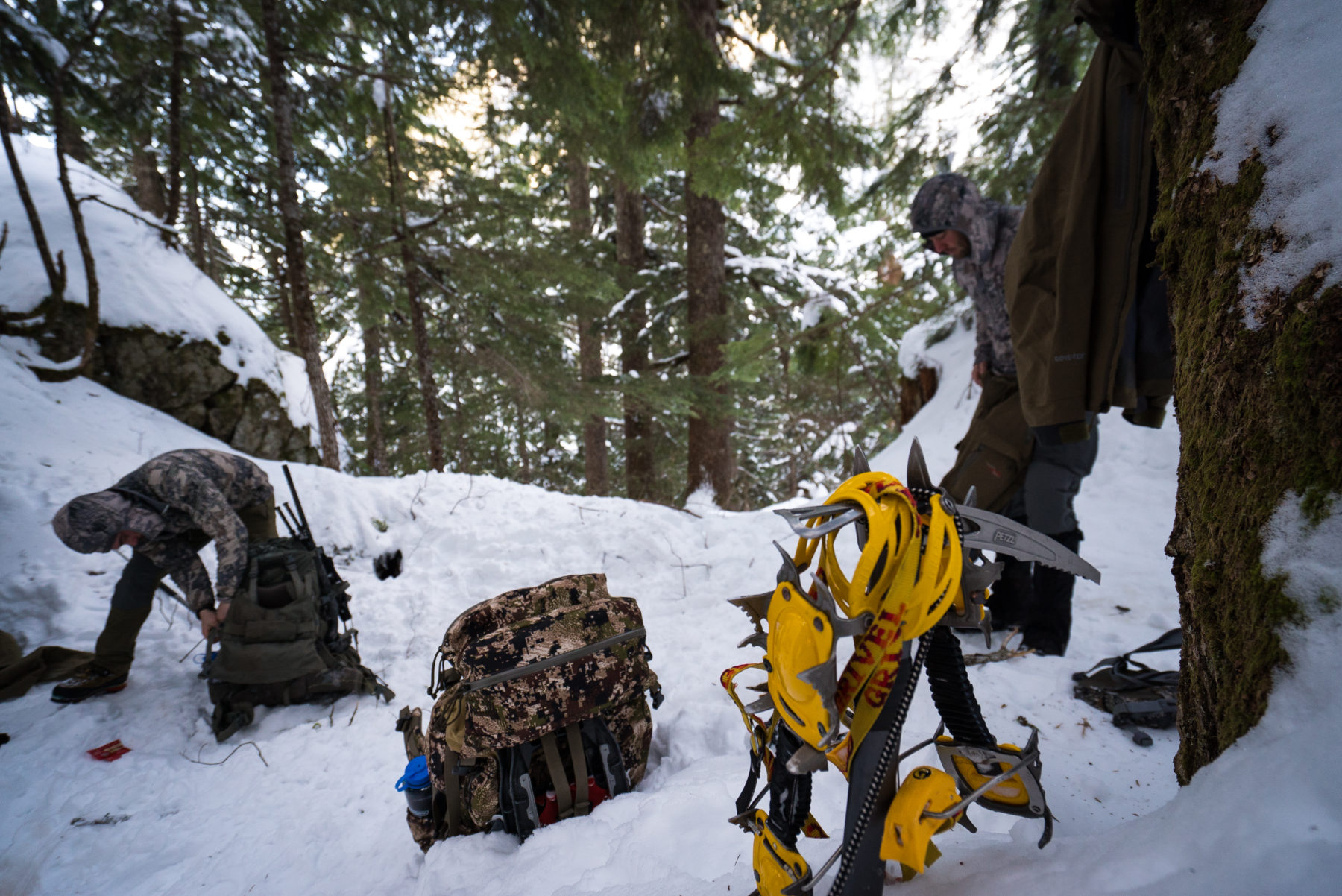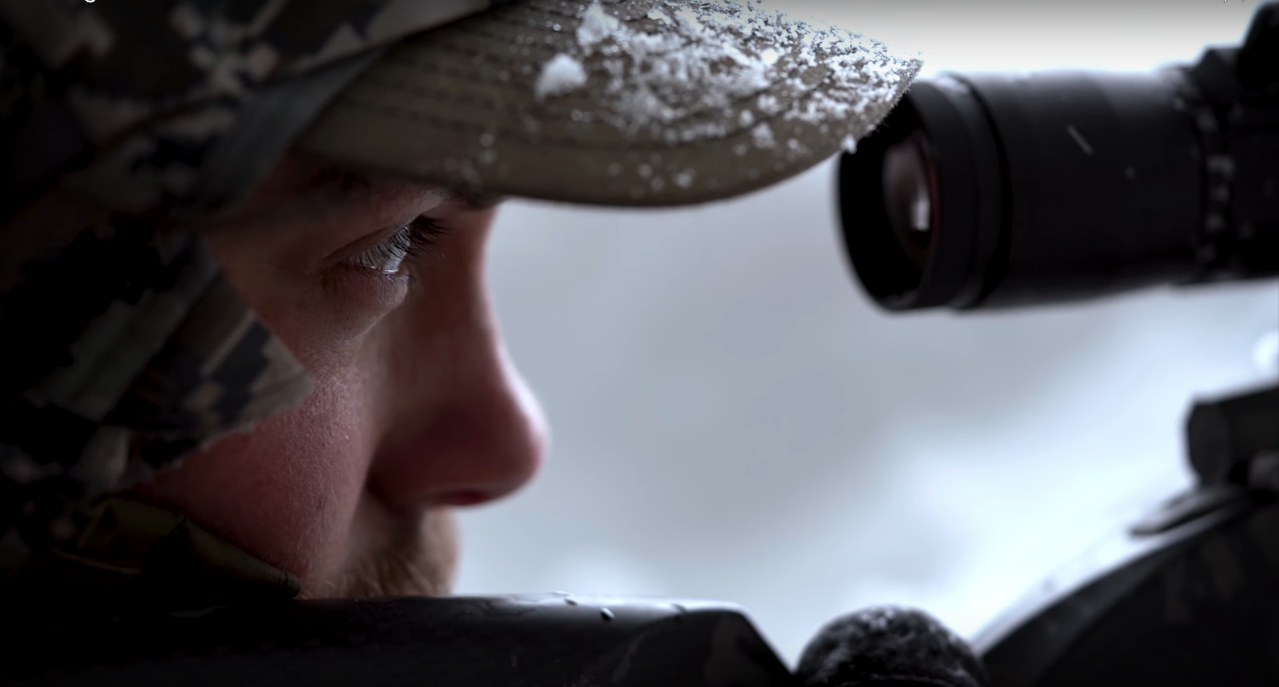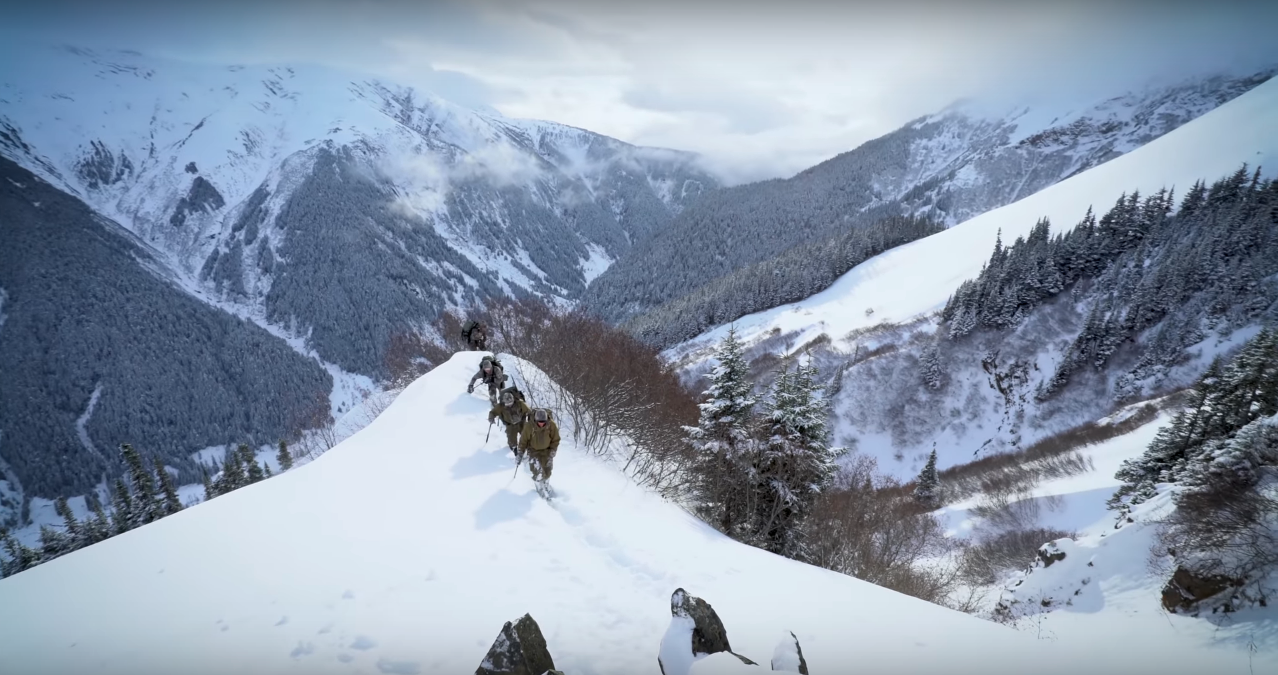By the time that this is published, I will be nearly halfway through an eighteen-hour drive North. For those of you who may find this later on, it’s late February, a rather slow time of year for hunting. Luckily, for dedicated hunters in British Columbia, a number of options exist. Predator hunting–often overlooked but ever important, Mountain lion, and Bison comes to mind. However, for hunters with an inclination towards adventure, the late Mountain Goat hunts in British Columbia offer up a special blend of backpack hunting, a hunt that is as much about the destination as the quarry pursued. If you haven’t caught on yet, the JOMH crew loves a winter goat hunt.
The Rocky Mountain Goat, Oreamnos Americanos, the Beast the Color of Winter. Whatever name you choose to call it, you can be certain that they are the pinnacle of mountain-dwelling critters. Largely underrated due to their lack of headgear, what they lack in horn size, they make up for in ruggedness and hair growth.
In hunting, they have made a name for themselves as not only one of the toughest animals–pound for pound–that call the mountains home, but also for the physical nature of the hunt itself. I was once told that there are two kinds of hunters: those who hunt goats once and never again, and those who will pursue them until their legs are too old and worn to carry them up the mountain.
B.C’s goat population, though not studied heavily, is estimated at approximately 50’000 animals—half of the world population. The remaining goats in North America are spread out across the western United States, Alaska, Yukon Territory, and the Northwest Territories. If the mountains of British Columbia are the kingdom of the mountain goat, then surely the Coast Range is their stronghold.
Typical hunting seasons throughout the province fall somewhere between August 1st – November 15th, depending on the region, and density of the population in question. They can be found in nearly every mountainous region between the Similkameen Valley of Southern BC, to the Tatsenshini-Alsek wilderness of the Northwest — with exceptions being the mountains of Vancouver Island in the south, and the Haida Gwaii archipelago to the north.
And while the general open season (GOS) in British Columbia offers plentiful opportunities to fill an over the counter goat tag, the province also has a Limited Entry Hunt (LEH) lottery option. The LEH system is in place for management units holding populations that need to be managed more conservatively, or in the case of the North Coast Mountains, to extend the hunting season and provide controlled opportunity. As far as LEH lotteries go, these are generally higher odds of drawing, in part because of the lower interest in hunting mountain goats vs sheep, or other game, but also due to the often brutal conditions that these hunts take place in. Deep snow, temperatures well below zero–you hope, otherwise it is rain and fog–and steep, timbered and cliff-laden terrain are the norms.
So you might be wondering, why would anyone bother with this? Why wouldn’t you hunt goats in August, when they are roaming the alpine meadows and scree slopes, napping lazily in the sun…
There are a variety of reasons that one may choose to pursue goats in the winter time, though none of them are particularly convincing in and of themselves. Some folks like the challenge. They want to find the most extreme hunts in extreme conditions, to have the odds stacked against them so they can push their boundaries and feel accomplished. Others value the great hair length of a winter billy, and I must attest to this. The long shaggy cape of a winter billy is as much of a trophy as the horns, or the experience itself.
In my case, there really aren’t a lot of “mountain” hunting opportunities I get outside of my guiding season, which runs from mid-July through mid-October. Frankly, I’m not a big fan of hunting goats in the never-ending torrent of rain that is November on the north coast. I’ve done a little bit of guiding at that time of year in that region, and it is not a matter of “if” you will have days where you are rained out and fogged in, but “how many”. December, while perhaps a little better off in the rain department, still sees mild temperatures, and often heavy, wet snows. I went down that road in 2015, and we had very few windows of opportunity to find or stalk goats.
December is also not an ideal time of year due to daylight hours–or lack thereof. The aforementioned goat hunt I went on fell over December 21st, with sunrise around 09:00 and sunset at 16:00. This makes for long evenings, and not a lot of time to make a play on a billy, especially when coupled with snow or fog. January can be a better time of year to go, especially later on as the days get longer, and snowpack builds and settles.
For many avid goat hunters, February is the preferred time of year to chase them. It certainly is for me. Late February has a few advantages, and the later the better in my eyes. For one, your days are substantially longer. 10 ¾ hours of daylight on February 28th vs. 7 hours on December 21st… nearly 4 hours can make a world of difference in the mountains. As well, the snowpack has generally built and settled, allowing easier travel over rivers and up small ledges and cliffs. Trying to navigate suitable river crossing locations when its -20C isn’t much fun, and it burns up a lot of time to boot. And lastly, the later you go, the longer the hair–it is truly impressive to see their great, ivory manes blowing around as they clamber over the side of a mountain.
There are a number of safety precautions that should be addressed when it comes to hunting mountain goats in the winter or spending any time in the backcountry during this time of year. I personally dislike the propensity to up-play drama and danger that often pops up within writings of the hunting community, however, hunting in the mountains during the winter does have a few added levels of danger over the average mountain hunt.
Avalanches are my number one concern, as they should be for anyone spending time in the mountain backcountry during the snowy months. I won’t dive too deeply into this subject because frankly, I’m not an expert, but there are numerous resources available on the subject. For Canadians, Avalanche Canada is an incredible resource, and there is a smartphone app that gives you regular updates on snowpack conditions and risks associated. A couple years back, we also ran an article from Ben Reynolds, titled Avalanche Assessment & Mountain Hunting, which looks at avalanche terrain as it pertains to the mountain hunter. Unlike the backcountry skier or snowboarder, the risks posed to a hunter in avalanche terrain are not always as apparent as one might think. There are a number of options for avalanche courses throughout western North America, and I strongly urge anyone considering these type of hunts for themselves to look into one. At the very least, it’s great to learn new skills and become familiarized with the terrain you might encounter, in any winter mountain activities.
Similar to the risk of avalanches and avalanche terrain, the terrain of the coast mountains themselves can be quite challenging. I was once told by an old guide, “these aren’t your rolling sheep hill’s”, and I’d say that’s a pretty accurate statement. Goats often favour the low snowpack areas, which typically means high angle terrain and windswept cliffs. As with all goat hunting, it’s not so much a matter of locating a mature billy so much as it is finding one in an area that is accessible, and where the billy won’t become hung up in the middle of a cliff band. I personally carry a light climbing rope, in case I need to tie myself or a goat off, as well as having the option to lower packs down steep terrain. Unless you have a strong understanding of climbing, rappelling, and belaying, I would advise against taking climbing harnesses. While having the right equipment is important, it can become easy to rely on equipment that you don’t know how to use properly, which is exactly what you shouldn’t be doing when climbing after goats.
Cold weather can also be a safety consideration, although significantly less so than avalanches. For those already living in colder climes, this one is pretty simple, and I have written a piece specifically on cold weather layering systems–for high output activities–in the past. The only real downside I see to backpacking in truly cold weather is the added gear weight that ends up in your pack. Bulkier down parka’s and pants, synthetic sleeping bags rated for sub-zero temps, crampons, ice axe’s, snowshoes… not to mention the added food weight to make up needed calories per day. It gets heavy quick and no matter what pack you run, it’s not fun going in heavy.
Hunting mountain goats in the winter is an incredible experience. It can push your limits, both physically and mentally, and can certainly become “extreme” depending on the terrain you find them in. Watching goats navigate the snow-covered peaks and cliffs in the dead of winter is truly awe-inspiring, as they exist in an environment that no other animal–save for the wolverine–can. For B.C. residents, it is an incredible way to extend your hunting season, test gear and your own mettle, should you be lucky enough to draw a LEH tag. For the non-resident, it is the hunt of a lifetime, a unique opportunity for a long-horned, and haired, old billy. On the coast, Milligan’s Outfitting & Bolen Lewis both offer limited, but fantastic hunts for those after a winter goat hunt, and they will handle the logistics and safety aspects for you.
This marks the fifth season that a member of the JOMH crew is after goats in the winter, and though we have been accused of being gluttons for punishment, it isn’t as bad as it sounds. Sheep have, and likely always will hold the spotlight for mountain animals, and they hold a special place for me as well. However, I think Douglas Chadwick hit the nail on the head in the introduction of his book, A Beast The Color of Winter, when he wrote “In North America there is one large animal that belongs almost entirely to the realm of towering rock and unmelting snow. Pressing hard against the upper limit of life’s possibilities, it exists higher and steeper throughout the year than any other big beast on the continent. It is possibly the best and most complete mountaineer that ever existed on any continent. Oreamnos americanus is its scientific name. Its common name is the mountain goat.”





